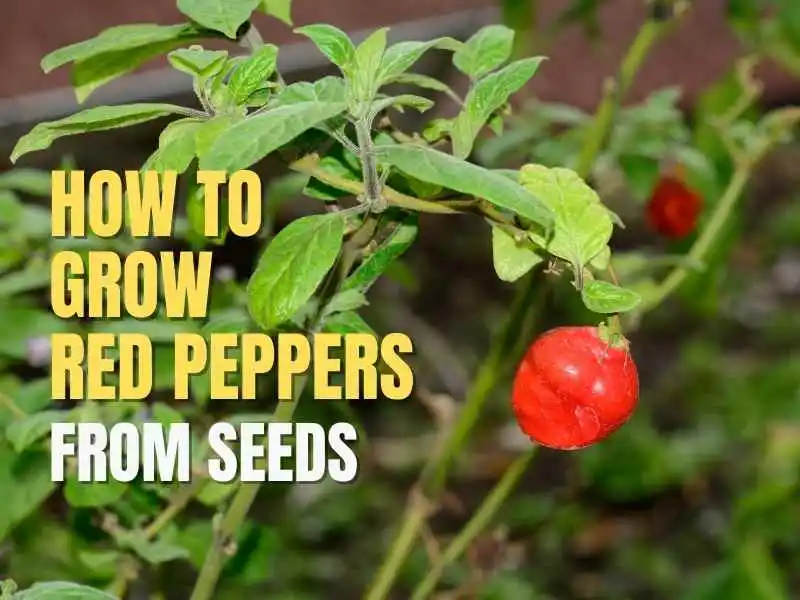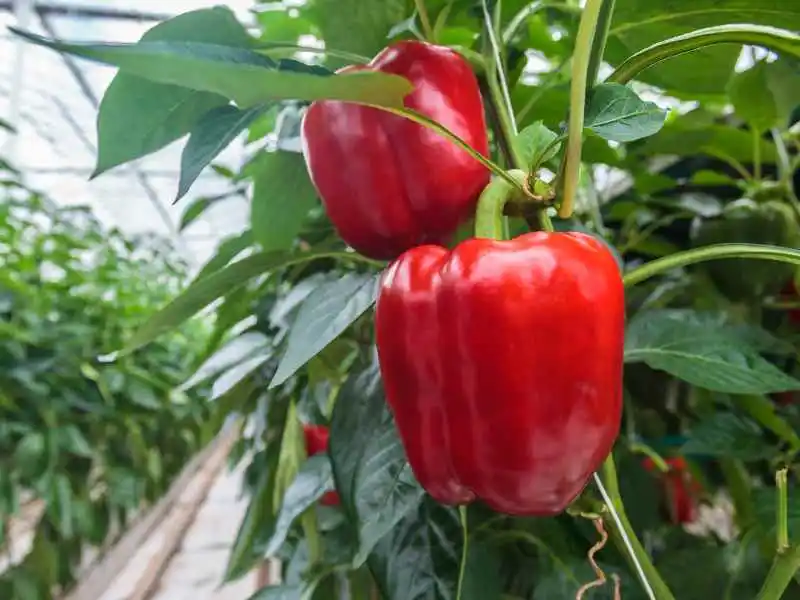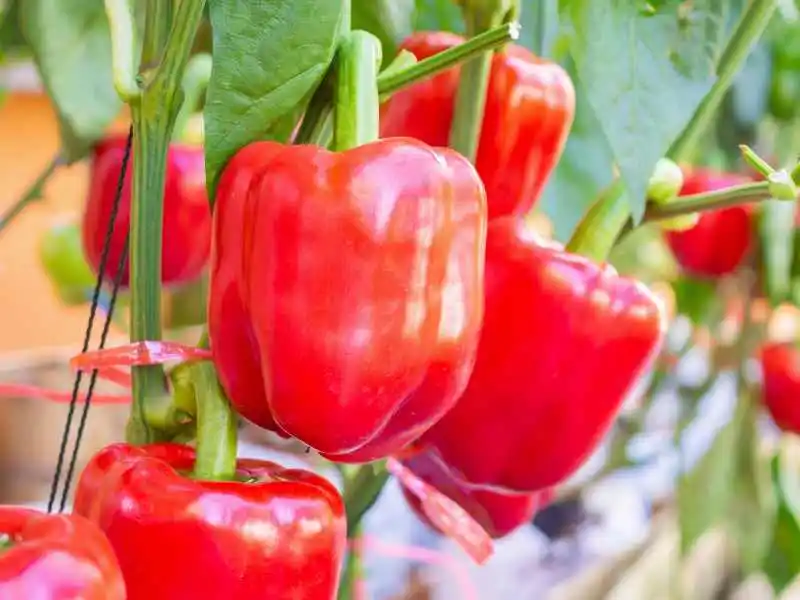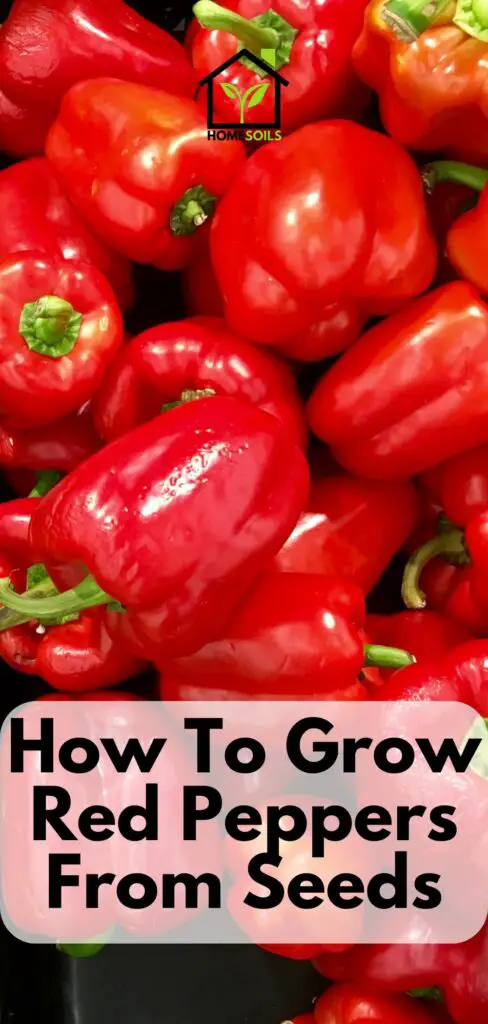Red peppers, also known as red bell peppers or sweet peppers, belong to the family of capsicum annuum. Known for its mildly sweet taste, it is a widely used vegetable. This vegetable also comes in different colors but we will cover this article about how to grow red peppers from seeds.

Before further continuing the topic, we shall first have a look at the nutritional value and health benefits of this popular vegetable.
Health Benefits of Red Pepper
Enriched with vitamins A and C, rep peppers are commonly used as a staple in many parts of the world. Consuming red pepper could fulfill much of your vitamin A, vitamin K, vitamin E, and vitamin C needs.
If you use the red pepper in raw form, you are taking the maximum amount of vitamin C from it. This vitamin helps boost your immune system and it is also an excellent antioxidant.
The vitamin A present in it is very helpful in improving your eye health. This vitamin also helps to boost the growth of blood cells.
Nutritional Value Of Red Bell Peppers
Along with vitamins, red peppers also contain lots of minerals and antioxidants too. Iron, magnesium, potassium, folate, niacin, and vitamin B6 are also found in red bell peppers. They also provide calories, carbohydrates, sugar, fiber, protein, and sodium.
How To Start A Red Pepper Plant
First of all, you have to choose the variety of peppers that actually produce red fruit. To our knowledge, it’s the green bell peppers that actually turn red when they are allowed to mature for some time. They have a sweet taste. The varieties you can choose to start your red pepper plant are as under.
- Lady bell
- Sweet Red Marconi
- Bellboy
- Sweet California Wonder
- Gypsy
- Lipstick
These will provide you with the red pepper you wanted. Get the seeds or the seedlings of the varieties told above.
Red Pepper Seed Selection

Can you plant the seeds from a bell pepper?
Don’t go for the seeds from any grocery store as they won’t produce a satisfying harvest. Try to get the seeds from open-pollinated varieties as they are more likely to perform very well. The best thing you can do to get the best seeds is from any garden that grows the most organic pepper plants.
How to Grow bell peppers from Scraps
Look for the fully matured red pepper fruit. Choose the fully ripe one that has its skin started to get wrinkly. Take that pepper and slice it. After that take the seeds from it and now you can plant the seeds directly to start a new plant or else you can also store them for later use.
Storing The Seeds
How do you prepare pepper seeds for planting?
If you are starting from freshly collected seeds, that’s good.
Do pepper seeds need to be dried before planting?
But if you want to store them for later use, place the collected seeds on some paper and keep them in a dark shady place that must also be a dry place. The seeds will fully dry up in about a week.
Now you can store them for even up to 2 years. They can be stored in a plastic wrap or a glass jar, just make sure they remain safe from any kind of moisture.
When To Plant Red Peppers
Red pepper plant seeds love warm temperatures to sprout.
What month to plant peppers?
It’s better to start them about 2 to 2 and a half months before the frost of the spring season begins. Every area has its own variable temperatures so adjust according to the area in which you are growing them.
Start From Red Pepper Seeds Indoors
Can you grow peppers indoors?
You can start by planting seeds indoors as the red peppers germinate well in warm temperatures, 70 to 85 Fahrenheit would suit the best. A temperature less than this will surely affect the germination process.
Can I start pepper seeds in potting soil?
Plant the seeds in a germination tray or you can also use seed starting pellets. Fill the tray with potting soil and plant seeds for about 0.25 inches in the soil. Water them after this step and make sure they remain in a warm place and receive sunlight too.
How long does it take for red pepper seeds to germinate?
The germination time varies according to the varieties but you can keep in mind that it may take from one week to three weeks.
Hardening Off
After you see a couple of leaves appearing on seedlings they have now become ready to be shifted to their final place outdoors in some container or garden soil. But before moving them to their final you have to harden them off first.
Before planting them outside, gradually introduce them to the outer atmosphere. Keep them outside for one hour on their first day and keep on increasing this time every next day. This way these young plants would get used to the outer temperature and this will also save them from getting transplant shock.
Transplant The Red Peppers
After the stage of hardening off, new red pepper plants are ready to be transplanted outside. It’s best to shift them outside when outdoor temperatures exceed 65 degrees Fahrenheit.
You can use containers, raised beds, or directly the garden soil to plant the seedlings. Keep at least one and a half to 2 feet distance between each seedling.
Soil For Red Peppers
Rich soil with good drainage is best for growing peppers. You should check the pH of your soil, it must be acidic and range between a pH of 6.0 to 7.0. Soil that has sand in it is best and it should be loamy to get ideal results.
Site Selection For Pepper Plant
Peppers like sunny and bright spots to grow. They should be placed in a location that doesn’t get shady during the day. The minimum amount of sunlight they need is 6 hours a day. Choose the location accordingly and also make sure that your plants do not get sunscalded because of the extremely hot weather conditions.
Choosing The Container For Red Peppers
If you have enough garden space to grow the peppers that are great. But in the other case, you can choose containers or raised beds for growing the red peppers. Another good news is that you can also grow them totally indoors.
Whether you grow them in containers or raised beds, make sure that whatever you choose, should have good drainage. Using gravel at the bottom of containers is a good way to keep drainage well. A 5-gallon container is good for planting red peppers.
Watering the Red Peppers
How often should I water pepper seeds?
Red peppers are water-loving crops. They need lots of water. So water them at least one to two inches every week. This much water will ensure the sweet and rich taste of your harvest. If not watered properly, you will get bitter-tasting red peppers. Keep checking the soil for water needs, sticking a finger one to two inches down will tell you if the plant needs water or not.
Growing in containers can be beneficial regarding the water needs of your plant. Just lift the container up for checking the water level of the soil. Dry soil will be less in weight so you could know that now is the time to water. Don’t overwater the plant as it could result in blossom end rot. So you should keep a balanced watering routine.
If you are living in areas with extreme heat. The water needs for red peppers get increased in such areas. Maybe you need to water them twice than the regular routine.
Mulching
In order to keep the soil temperature warm and provide a good growing environment, mulching could be very beneficial. You can use black plastic mulch or grass clippings for this purpose. They will help keep the soil temperature warm, as needed by the red peppers.
Fertilizing the Soil
If your plant is not receiving the required fertilizers at every stage, you could possibly see the yellowing of leaves. It’s important to provide some good fertilizers. You can use liquid seaweed and potassium-rich fertilizers at the flower production stage. During the fruit growing stage, need low-nitrogen feed to grow properly.
Stake The Pepper Plant
Staking the red peppers could be helpful during the growing process. They can keep the plant on the ground and keep them safe from pests. You can use wooden stakes and tie the plant to keep them in place. Tomatoes cages are also a good option for this job. Although the pepper plants don’t need to get staked it will prove to be beneficial.
Companion Plants
Peppers’ plant loves cucumbers and carrots around them. It is a good technique to grow companion plants around your peppers. But keep in mind that peppers don’t like cabbage families near them and they would not grow well near them. So keep your peppers away from this family.
Pests Of Red Peppers
Aphids, spider mites, and Flea beetles are some of the main enemies of your pepper plants. Keep looking for them if the plant gets attacked by them and use organic pesticides as soon as the first signs appear. Separate the affected plant from other peppers plants to stop the spread of these pests.
Harvest The Red Peppers

How long does it take to grow peppers from seed?
The ripening time for peppers is 65 to 80 days and that depends on the variety. As told before that red peppers are actually green peppers that are left to ripen for a longer time to turn yellow, then orange, and finally to the red-colored peppers that you desire.
Once you see the red peppers reach maturity in color and size, you can now harvest them. Now they will have a sweet taste and high vitamin C level.
Remember to always use a sharp knife or scissors for picking your harvest as handpicking them could damage the peppers. If you pick the harvest regularly and on time, it could also boost the future growth of your plant.
Store the Red Peppers
Freshly harvested red peppers have the richest and the most liked flavor but you can also store them for up to ten days if they are refrigerated by covering them in plastic bags.
You can also dry them and store them for a longer period of time.

READ THIS
HOW TO GROW CAULIFLOWER AT HOME WITHOUT SEEDS
HOW TO GROW RED ONIONS FROM SCRAPS
References
https://www.masterclass.com/articles/how-to-grow-bell-peppers#what-are-bell-peppers

